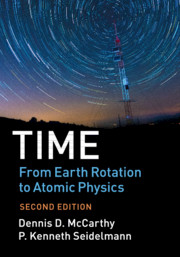Book contents
- Time: From Earth Rotation to Atomic Physics
- Time: From Earth Rotation to Atomic Physics
- Copyright page
- Dedication
- Contents
- Preface
- 1 Time Before the 20th Century
- 2 Time from the Earth’s Rotation
- 3 Ephemerides
- 4 Variable Earth Rotation
- 5 Earth Orientation
- 6 Ephemeris Time
- 7 Relativity and Time
- 8 Time and Cosmology
- 9 Dynamical and Coordinate Timescales
- 10 Clock Developments
- 11 Microwave Atomic Clocks
- 12 Optical Atomic Standards
- 13 Definition and Role of a Second
- 14 International Atomic Time (TAI)
- 15 Coordinated Universal Time (UTC)
- 16 Time in the Solar System
- 17 Time and Frequency Transfer
- 18 Modern Earth Orientation
- 19 International Activities
- 20 Time Applications
- 21 Future of Timekeeping
- Acronyms
- Glossary
- Index
- References
8 - Time and Cosmology
Published online by Cambridge University Press: 01 October 2018
- Time: From Earth Rotation to Atomic Physics
- Time: From Earth Rotation to Atomic Physics
- Copyright page
- Dedication
- Contents
- Preface
- 1 Time Before the 20th Century
- 2 Time from the Earth’s Rotation
- 3 Ephemerides
- 4 Variable Earth Rotation
- 5 Earth Orientation
- 6 Ephemeris Time
- 7 Relativity and Time
- 8 Time and Cosmology
- 9 Dynamical and Coordinate Timescales
- 10 Clock Developments
- 11 Microwave Atomic Clocks
- 12 Optical Atomic Standards
- 13 Definition and Role of a Second
- 14 International Atomic Time (TAI)
- 15 Coordinated Universal Time (UTC)
- 16 Time in the Solar System
- 17 Time and Frequency Transfer
- 18 Modern Earth Orientation
- 19 International Activities
- 20 Time Applications
- 21 Future of Timekeeping
- Acronyms
- Glossary
- Index
- References
Summary
- Type
- Chapter
- Information
- Time: From Earth Rotation to Atomic Physics , pp. 123 - 130Publisher: Cambridge University PressPrint publication year: 2018



